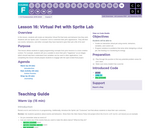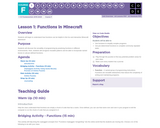
Here, students will use Sprite Lab to create their own customized behaviors.
- Subject:
- Computer Science
- Science
- Material Type:
- Lesson Plan
- Provider:
- Code.org
- Provider Set:
- CS Fundamentals 2019-2163
- Date Added:
- 11/06/2019

Here, students will use Sprite Lab to create their own customized behaviors.

In this lesson, students will create an interactive Virtual Pet that looks and behaves how they wish. Students will use Sprite Lab's "Costumes" tool to customize their pet's appearance. They will then use events, behaviors, and other concepts they have learned to give their pet a life of its own!

Students consider that while they are enjoying their favorite websites they may encounter messages from other kids that can make them feel angry, hurt, sad, or fearful. They explore ways to handle cyberbullying and how to respond in the face of upsetting language online.
Students discuss all the ways they use technology for communication and explore the similarities and differences between in-person and online communication. Students then brainstorm ways to respond to cyberbullying.
For more information, please visit: [r common-sense-media-power-of-words]

In computer science, we face some big, daunting problems. Challenges such as finding large prime numbers or sequencing DNA are almost impossible to do as an individual. Adding the power of others makes these tasks manageable. This lesson will show your students how helpful teamwork can be in the industry of computer science.

Loaned to Computer Science Fundamentals by the team over at Copyright and Creativity, this lesson exists to help students understand the challenges and benefits of respecting ownership and copyright, particularly in digital environments. Students should be encouraged to respect artists’ rights as an important part of being an ethical digital citizen.

Students will begin to understand how functions can be helpful in this fun and interactive Minecraft adventure!

The next five lessons provide an opportunity for students to put their coding skills to use in a capstone project. This project will help individuals gain experience with coding and produce an exemplar to share with peers and loved ones. This is intended to be a multi-lesson or multi-week project where students spend time brainstorming, learning about the design process, building, and then presenting their final work.
In the "Explore" stage, students will play around with pre-built Artist and Sprite Lab programs for inspiration. Next, students will learn about the design process and how to implement it in their own projects. They will then be given the space to create their own project in Artist, Sprite Lab, or any other interface that you are comfortable providing. (This is likely the longest stage of the project.) Students will then revise their code after testing and peer review. Finally, students will be able to present their finished work to their classmates.

In this lesson, students will learn about the two concepts at the heart of Sprite Lab: sprites and behaviors. Sprites are characters or objects on the screen that students can move, change, and manipulate. Behaviors are actions that sprites will take continuously until they are stopped.

This lesson features Sprite Lab, a platform where students can create their own interactive animations and games. In addition to behaviors, today students will incorporate user input as events to create an "alien dance party".

Watch student faces light up as they make their own gorgeous designs using a small number of blocks and digital stickers! This lesson builds on the understanding of loops from previous lessons and gives students a chance to be truly creative. This activity is fantastic for producing artifacts for portfolios or parent/teacher conferences.

In this online activity, students will have the opportunity to push their understanding of loops to a whole new level. Playing with the Bee and Plants vs Zombies, students will learn how to program a loop to be inside of another loop. They will also be encouraged to figure out how little changes in either loop will affect their program when they click `Run`.

Variables are used as placeholders for values such as numbers or words. Variables allow for a lot of freedom in programming. Instead of having to type out a phrase many times or remember an obscure number, computer scientists can use variables to reference them. This lesson helps to explain what variables are and how we can use them in many different ways. The idea of variables isn't an easy concept to grasp, so we recommend allowing plenty of time for discussion at the end of the lesson.

In this lesson, students will explore the creation of repetitive designs using variables in the Artist environment. Students will learn how variables can be used to make code easier to write and easier to read, even when the values don't change at runtime.

This lesson will help illustrate how variables can make programs more powerful by allowing values to change while the code is running.

In this lesson, students will explore the creation of repetitive designs using variables in the Artist environment. Students will learn how variables can be used to make code easier to write and easier to read. After guided puzzles, students will end in a freeplay level to show what they have learned and create their own designs.

Returning to loops, students learn to draw images by looping simple sequences of instructions. In the previous online lesson, loops were used to traverse a maze and collect treasure. Here, students use loops to create patterns. At the end of this stage, students will be given the opportunity to create their own images using loops.

In this online activity, students will have the opportunity to learn how to use events in Play Lab and to apply all of the coding skills they've learned to create an animated game. It's time to get creative and make a story in the Play Lab!

In this online activity, students will have the opportunity to learn how to use events in Play Lab and apply all of the coding skills that they've learned to create an animated game. It's time to get creative and make a game in Play Lab!

This lesson will give students an idea of what to expect when they head to the computer lab. It begins with a brief discussion introducing them to computer lab manners, then they will progress into using a computer to complete online puzzles.

Using Scrat from the Ice Age franchise, students will develop sequential algorithms to move a squirrel character from one side of a maze to the acorn at the other side. To do this they will stack code blocks together in a linear sequence.